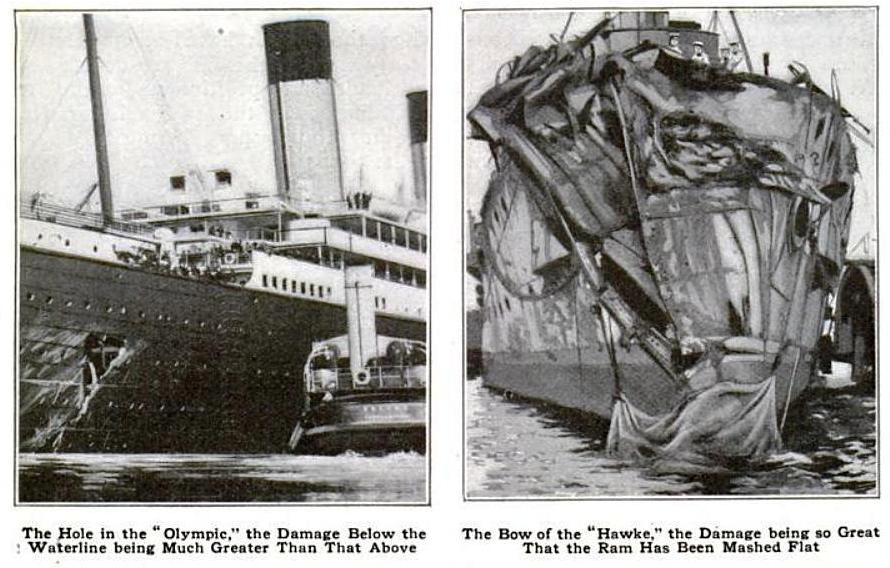Information
Hawke collision
Olympic's first major mishap occurred on her fifth voyage on 20 September 1911, when she collided with a British warship, HMS Hawke off the Isle of Wight. The collision took place as Olympic and Hawke were running parallel to each other through the Solent. As Olympic turned to starboard, the wide radius of her turn took the commander of the Hawke by surprise, and he was unable to take sufficient avoiding action. The Hawke's bow, which had been designed to sink ships by ramming them, collided with Olympic's starboard side near the stern, tearing two large holes in Olympic's hull, below and above the waterline respectively, resulting in the flooding of two of her watertight compartments and a twisted propeller shaft. HMS Hawke suffered severe damage to her bow and nearly capsized. Despite this, Olympic was able to return to Southampton under her own power, and no-one was seriously injured or killed.
Captain Edward Smith was still in command of Olympic at the time of the incident. One crew member, Violet Jessop, survived not only the collision with the Hawke but also the later sinking of Titanic and the 1916 sinking of Britannic, the third ship of the class.
At the subsequent inquiry the Royal Navy blamed Olympic for the incident, alleging that her large displacement generated a suction that pulled Hawke into her side. The Hawke incident was a financial disaster for Olympic's operator. A legal argument ensued which decided that the blame for the incident lay with Olympic, and although the ship was technically under the control of the pilot, the White Star Line was faced with large legal bills and the cost of repairing the ship, and keeping her out of revenue service made matters worse. However, the fact that Olympic endured such a serious collision and stayed afloat, appeared to vindicate the design of the Olympic-class liners and reinforced their "unsinkable" reputation.
Olympic (left) returning to Belfast for repairs in March 1912, and Titanic (right) This was the last time the two sister ships would be seen together. 
It took two weeks for the damage to Olympic to be patched up sufficiently to allow her to return to Belfast for permanent repairs, which took just over six weeks to complete. To speed up the repairs, Harland and Wolff was forced to delay Titanic's completion in order to use her propeller shaft for Olympic. By 29 November she was back in service, however in February 1912, Olympic suffered another setback when she lost a propeller blade on an eastbound voyage from New York, and once again returned to her builder for repairs. To get her back to service as soon as possible, Harland & Wolff again had to pull resources from Titanic, delaying her maiden voyage from 20 March 1912 to 10 April 1912.
Source: http://en.wikipedia.org/wiki/RMS_Olympic#Hawke_collision |
| Category: RMS Olympic | Added by: CunardWhiteStarLine (03/12/2013)
|
| Views: 2739
| Rating: 5.0/1 |
|
| Statistics |
Total online: 1 Guests: 1 Users: 0
|
 Website builder — uCoz
|